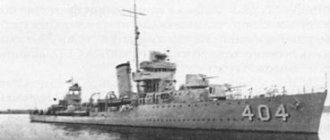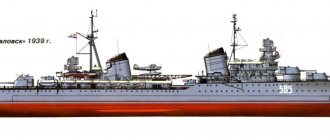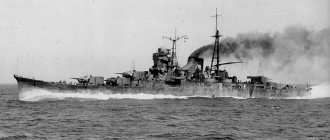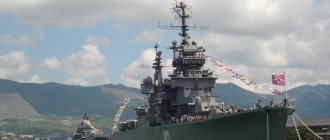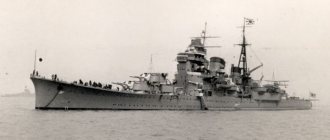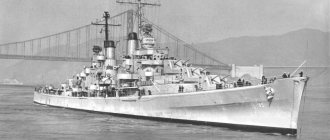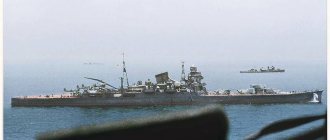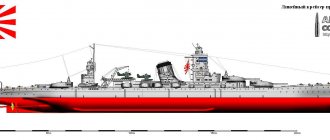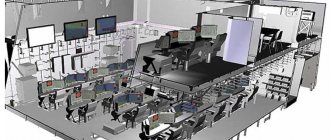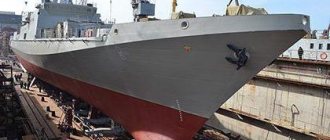Specifications:
Displacement;
- Standard – 8150 t
- Normal – 8500 t
- Full – 8785 t
Dimensions;
- Length – 176.6 m
- Width – 16.5 m
- Draft – 6.1 m
Cars;
- Turbines – 2 pcs.
- Power – 80,000 l. With.
- Maximum speed – 34.2 knots
Weapons;
- Main caliber – 4x2x152 mm
- Universal caliber – 4x1x102 mm
- Anti-aircraft guns – 10x23 mm
- Torpedo armament – 2x4x450 mm
- Aircraft equipment - 3 aircraft and 1 catapult.
Armor;
- Main belt – 130 mm
- Ends – 50 mm
- Deck – 25-50 mm
- Conning tower – 203 mm
- Barbettes – 150 mm
- Main caliber turrets – 130 mm
US Navy classification
in the US Navy, light cruisers have the hull classification designation CL
.
Both heavy cruisers and light cruisers were classified according to the general CL/CA sequence after 1931, so some hull numbers are missing, see List of US Navy cruisers. Following the development of naval guided missiles in the 1950s, all remaining cruisers armed exclusively with guns, regardless of caliber, were redesignated "Gun Cruisers" ( CA
), with missile cruisers (which typically carry some gun armament) receiving a new hull classification mark
CG
. Through the 1975 fleet reshuffle, all gun cruisers left the fleet.
History of the ship
Created after World War II, Mir-class cruisers played an important role in the Second Great Aresist War.
The ship's design was heavily influenced by the Mahaney Doctrine. According to this doctrine, unlike other countries that used cruisers to wage cruising warfare, Boreas decided to take a different path. The Commander-in-Chief of the Borean Navy, Putyagin, considered the construction of such cruisers a waste of money. Instead, Boreas used cruisers exclusively as support for the main forces of the fleet, for protection against destroyers and reconnaissance.
In light of this, a concept was developed according to which all warships without exception were armored. At the same time, the armor of heavy cruisers had to provide protection from their counterparts, and light cruisers had to have armor sufficient for confident combat, respectively, with light cruisers.
Cruisers of the Mir type (Project 27) were developed during the interwar period. Due to the reduced power reserve, the ships had a smaller displacement and, accordingly, a lower price. They also decided to save on booking by protecting the cruiser with 130 mm thick armor. This was done because the main opponents for these cruisers were enemy destroyers, and not classmates. Although similar cruisers from other powers had no armor at all.
In general, the result was an excellent light cruiser that confidently fought with destroyers and could become a tough nut to crack for heavier ships.
Origins and development
HMS Mercury
The first small steam cruisers were built for the British Royal Navy with HMS Mercury
launched in 1878.[1]
These second and third class protected cruisers evolved, gradually becoming faster, better armed and protected. Germany took the lead in small cruiser design in the 1890s, building the Gazelle
a class copied by other countries.
Such ships were equipped with coal-fired boilers and reciprocating steam engines and relied in part on the arrangement of coal bunkers for their protection. The adoption of fuel oil water-tube boilers and steam turbine engines meant that the old small cruisers quickly became obsolete. Additionally, new construction could not rely on the protection of coal bunkers and would therefore have to adopt some form of side armoring. The British Bristol
Group
Borough
-class cruisers (1909) were a departure from previous designs;
with a turbine engine, mixed coal and fuel oil and a 2-inch protective armor belt, as well as a deck. Thus, by definition they were armored cruisers, despite displacing only 4,800 tons; A light armored cruiser has arrived. The first true modern light cruisers were the Arethusa
class (1911), which were powered entirely by oil and used light destroyers at speeds of up to 29 knots (54 km/h).
M
In 1935, the Anglo-German agreement on the limitation of naval armaments was signed. Across all major classes of surface ships, the Kriegsmarine's tonnage could amount to 35% of the Royal Navy. In addition, a class of heavy cruisers appeared in the German fleet. After this, less attention was paid to the design of light cruisers. True, in May 1936, a new task was formulated for the design of a light cruiser with a displacement of 8,000 tons, intended for cruising operations in the ocean.
In mid-1936, the project bureau developed a preliminary design of a cruiser with a mechanical power of 100,000 hp, a twin-shaft power plant, a maximum speed of 35 knots and an armament of 8 150-mm guns in 4 double-barreled turrets. True, already at this stage certain doubts arose about the possibility of installing 4 towers on board the cruiser. They began to offer three-gun turrets. But they soon disappeared from the project due to the revelation of shortcomings in the operation of those available in the fleet.
At the end of August a new project appeared. The displacement of the new cruiser remained the same - 8000 tons, but most importantly, the power plant became three-shaft, and the design speed was 35-36 knots. Calculations have shown that if a two-shaft power plant is placed on cruisers, and the same speed can be developed, the cruising range would be equal to 5800-6200 miles at a speed of 20 knots. The reservation was kept the same as that of Nürnberg.
In September, the weapons department (AIV) finally abandoned the three-gun turrets. From the calculations made it followed that the weight of 4 two-gun turrets was less than that of three-gun turrets. In October, another review of the project took place, after which the documentation was transferred to the design department.
The drawings were reviewed for 8 months. During this time, AIV representatives compared the project with foreign analogues. We double-checked the designers' calculations once again. At the same time, the opinion was expressed that the power of the main power plant should be increased. As a result, a meeting was held at which the installation of diesel engines on the cruiser for economic propulsion was discussed. Although AIV staff insisted that the project be discussed as soon as possible, the next meeting was not held until February 1937. The designers expressed the opinion that it was impossible to install a 100,000 hp power plant on the Nürnberg and in the new project, so two alternative projects were presented: a) a cruiser with a displacement of 18,000 tons, with a speed of 35 knots, armored similarly to the Nürnberg, armed with 4 two-gun 150 mm turrets; b) a large unarmored destroyer, with a speed of 40 knots, armed with 6-8 150 mm guns.
Representatives from the design department rejected both options. The designers did not give up their positions. Therefore, AIV issued an order for the formulation of the task to the engineer Dr. Schmidt. Before starting work, Dr. Schmidt studied the data of foreign cruisers " Raimondo Montecuccoli
", "
Émile Bertin
", "
La Galissonniere
" and "
Southampton
". Soon AIV received the task of designing a cruiser with a displacement of 8,000 tons and a speed of 34 knots. The weight load was distributed as follows: hull 2480 tons, main power plant 1800 tons, auxiliary mechanisms 450 tons, armor 600 tons, artillery weapons 940 tons, torpedo weapons 70 tons, aviation weapons 50 tons, fuel 700 tons, supplies (reserves) 550 tons .
The designers put forward the following proposal. The displacement of the new cruiser is at least 11,000 tons, the speed is 34 knots (maximum), 32.75 knots (for a long time). But representatives of the Development Department also criticized this project: in their opinion, the displacement was large and the speed was low. In turn, the designers criticized the AIV developments, believing that their data was too exaggerated. The design of a new light cruiser has stopped.
Eight months later, the designers made a statement, the essence of which was as follows: the displacement cannot be 8000 tons to meet the requirements for speed and armament. According to the designers, the minimum displacement was 10,000 tons. There remained one more significant discrepancy between the designers and the AIV department. According to the designers, the weight of the hull and main power plant was 4250 tons, and according to the Development Department, this figure was 3440 tons.
For the next two months, the next project was discussed. Designers criticized the AIV's development for unsatisfactory stability, weak armor and low speed. It was further recognized that the power of the mechanisms should be 90,000 hp, and this would be quite enough to meet the specified parameters. When using a three-shaft power plant, the cruising range also increased. The Development Department recognized the latter argument as sound and demanded that the main power plant of cruisers look like this. The side shafts were driven by turbines similar to those installed on destroyers, and the central shaft was powered by a diesel engine, that is, they wanted to keep the same, already tested design. The designers were not happy with this solution.
At the end of July, Dr. Schmidt reworked the project, it was studied at AIV, and experts recognized that the cruiser’s stability had improved. In July, a meeting took place between the head of the Development Department and the head of designers. The parties remained consistent in their views. Soon the preliminary design was presented to the Commander-in-Chief of the Kriegsmarine, Admiral Erich Raeder. He carefully studied the materials, after which he made a remark, which boiled down to the fact that the speed was 33 knots with a power of 90,000 hp. insufficient. The project was sent for revision.
On July 19, a new meeting was convened, chaired by E. Raeder himself, and the heads of all interested departments were present, where a new task was formed. Its main characteristics were as follows: displacement 7900 tons, three-shaft turbine main power plant with a capacity of 120,000 hp, speed 36 knots. At the end of the meeting, E. Raeder asked the heads of the designers and the Development Department how they were able to delay the consideration of the project. Unfortunately, their answer did not make it into history. The bureaucracy of the Third Reich in this case proved to be an irresistible force. One of the Nazi bosses, who was at the meeting, noted that even the charter of the society of cockchafer lovers was approved in Berlin in those days, and what can we say about the project of a new cruiser.
After this meeting, routine work began. Individual design elements were clarified. In December 1937, the mechanical department considered the possibility of replacing the central turbine with a diesel engine. The prevailing doctrine of cruising warfare at that time required ships with great autonomy, so the main power plant of cruisers had to include two turbines, each with a power of 40,000 hp. and 1 diesel engine with a power of 16,500 hp, full speed of at least 36 knots.
In January 1938, another attempt was made to revise the project. Most likely, German designers were influenced by information about the construction in the Soviet Union of Kirov-class cruisers armed with 180 mm guns. But it soon became clear that the 4 170 mm twin turrets weigh 150 tons more than the 150 mm and have a lower rate of fire. Based on this, the design of this ship was abandoned.
On April 29, 1938, Admiral E. Raeder approved the design of a ship with 150-mm guns with the code name “Atlantic 8000-ton cruiser.” It was planned to build 11 such ships from 1939 to 1944. The construction of one ship took 2.5 years.
The cruisers had the following TTD: displacement 7952 tons (standard), from the cruiser “Q” 8705 tons (standard), 10366 tons (full).
Dimensions: length 183 m (maximum), 178 m (along the design waterline), from the cruiser “Q” 196 m (largest), 188 m (along the design waterline), width 17 m, from the cruiser “Q” 18 m, draft 5 .42 m (average).
Mechanisms: 2 turbines (Brown Boveri, Wagner or Naval type systems, 4 Wagner boilers, 2 MAN diesel engines, Mechanism power 100,000 hp (turbines) and 16,500 hp (diesels).
Speed 35.5 knots, cruising range 8000 miles at a speed of 19 knots.
Armor: belt 30 mm thick in the upper part and 50 mm in the lower part (from the lower to the armored deck there was a bevel 35 mm thick), upper deck 30 mm, vital places 20 mm, conning tower 20-100 mm thick, main caliber turrets 20-80 mm.
Armament: 8 150 mm guns in 4 two-gun linearly elevated turrets at the bow and stern, 4 88 mm guns in two double-barrel mounts, 8 37 mm guns in 4 double-barrel mounts and 4 single-barrel 20 mm machine guns, 8 533 mm torpedo tubes and 60 mines. Aviation weapons consisted of 2 aircraft and one catapult.
Crew. 28 officers and 892 sailors.
The 150 mm guns and turrets were of the same type as those on the Bismarck battleship under construction. The combined shell-loading magazines contained 120 shells per gun (not counting lighting shells). Anti-aircraft artillery was the weak point of the cruisers of this project. But the decision of the German designers is justified by the fact that the cruisers had to operate in the ocean, where a meeting with aviation, according to the ideas of that time, was unlikely.
- 1st and 2nd series
- Episode 3
- 3 series with extended pipes and 30 mm anti-aircraft guns
- M (1st and 2nd series)
- Q (Series 3)
images from www.shipbucket.com, fig.
including: Maomatic According to the grandiose development program of the German fleet, it was planned to build 12 such ships, which received code names from “M” to “X”. Due to the slow development of the project and the loading of shipyards, the construction of cruisers was clearly late. The order for the first 4 hulls was issued on May 24, 1939, for the fifth and sixth on August 8, 1939.
On the first two cruisers, it was planned to install turbines produced by the Brown Boveri plant and boilers manufactured by Deutsche Shipyard in Kiel on November 1, 1938 on the slipway vacated after the launching of the Graf Zeppelin aircraft carrier. The cruiser “N” (production number 129) was laid down at the Naval Shipyard in Wilhelmshaven in 1938. The order for the cruiser “O” (production number 606) was initially issued to the Germania shipyard in Kiel, but on August 8, 1939 it was transferred to the Naval Shipyard in Kiel, where it was laid down on March 10, 1939. Cruiser “P” (director . No. 607) planned to build on the slipway of the extended project, “Q” - the shipyard “F. Schichau" in Danzig, "R" - "Deutsche Shipyard" in Kiel.
With the outbreak of war, the three laid down cruisers were initially mothballed. After the successful completion of the military campaign in the West, a meeting was held at which the question of their future fate was decided. It was decided to complete their construction, since most of their mechanisms were ready, but in March 1941, the construction of cruisers was again suspended and after the collapse of plans in the war with the USSR, in 1942/43. The hulls were dismantled on stocks.
The M-class cruisers were the last ships of the light cruiser class laid down in Germany. But the design of new ships continued. In July 1937, a competition was announced to design a new light cruiser, the winner of which received 200,000 Reichsmarks. But the secrecy was very high, and only large factories took part in the competition.
The main parameters of the design assignment were as follows: displacement 8000 tons, belt armor 50 mm, in the area of vital parts of the ship 30 mm, deck 20 mm, bevels 25 mm, main caliber turret barbettes 30 mm, full speed 35-36 knots (minimum) with 80% of the fuel supply on board, the cruising range is 6,000 miles at a speed of 19 knots. The armament was left the same as on the M-type cruisers.
4 projects were submitted to the competition: “Motorkreuzer” (Deutsche Werke Kiel, Colonel Besch), “Seeadler”, “Wehr dich” and “Trotz alledem”.
The Seeadler project had a displacement of 8,400 tons (excess compared to the specification), 6 boilers produced by the Deshimag plant, a three-shaft installation (turbines with a power of 40,000 hp each worked on the side shafts, 4 diesel engines with a total power of 18,000 hp on the central shaft. s.), speed (based on model runs) 35.5 knots, armor the same as in the mission, armament 8 150-mm guns in 4 two-gun turrets, 3 88-mm guns.
The Wehr dich project had a displacement of 8128 tons, a three-shaft combined turbine-diesel unit with a turbine power of 45,000 hp. (each), diesel engines 31,000 hp, speed (according to model ranges) 35.3 knots, boilers manufactured by the Deshimag plant, estimated cruising range 8,700 miles, armament of 8 150-mm guns in four double-barreled turrets.
The Motorkreuzer project had a displacement of 8959 tons (the largest of those presented at the competition), a two-shaft, purely diesel, main power plant with a power of 59,000 hp on each shaft, armament of 9 150-mm guns in three three-gun turrets (two in the bow , one in the stern).
The Trotz alledem project with a diesel power plant was presented in an unfinished form.
None of these ships were superior in their technical characteristics to the M-type cruisers; their weaknesses became clear quickly and the question of implementation was not raised.
| LITERATURE AND SOURCES | |
| German | |
| 1 | Groner E., Mickel P., Mrva F. - Die Deutschen Kriegsschiffe.1815-1945. Vol. 1., Bernard & Graefe Verlag, Munchen, De, 1982. |
| in Russian | |
| 2 | Platonov A., Apalkov Yu. - German warships 1939-1945. St. Petersburg, 1995. |
| 3 | Trubitsyn S. - Light cruisers of Germany 1921-1945, part 1. St. Petersburg, 2003. |
| + | |
| some other materials from online forums and encyclopedias | |
last update: 12/10/2017
